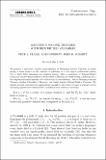| dc.contributor.author | Clark, Pete L. | |
| dc.contributor.author | Forrow, Aden | |
| dc.contributor.author | Schmitt, John R. | |
| dc.date.accessioned | 2017-02-02T21:59:54Z | |
| dc.date.available | 2017-03-01T16:14:47Z | |
| dc.date.issued | 2016-05 | |
| dc.date.submitted | 2014-05 | |
| dc.identifier.issn | 0209-9683 | |
| dc.identifier.issn | 1439-6912 | |
| dc.identifier.uri | http://hdl.handle.net/1721.1/106843 | |
| dc.description.abstract | We present a restricted variable generalization of Warning’s Second Theorem (a result giving a lower bound on the number of solutions of a low degree polynomial system over a finite field, assuming one solution exists). This is analogous to Schauz-Brink’s restricted variable generalization of Chevalley’s Theorem (a result giving conditions for a low degree polynomial system not to have exactly one solution). Just as Warning’s Second Theorem implies Chevalley’s Theorem, our result implies Schauz-Brink’s Theorem. We include several combinatorial applications, enough to show that we have a general tool for obtaining quantitative refinements of combinatorial existence theorems.
Let q = p[superscript ℓ] be a power of a prime number p, and let F[subscript q] be “the” finite field of order q. For a[subscript 1],...,a[subscript n], N∈Z[superscript +], we denote by m(a[subscript 1],...,a[subscript n];N)∈Z[superscript +] a certain combinatorial quantity defined and computed in Section 2.1. | en_US |
| dc.publisher | Springer Berlin Heidelberg | en_US |
| dc.relation.isversionof | http://dx.doi.org/10.1007/s00493-015-3267-8 | en_US |
| dc.rights | Article is made available in accordance with the publisher's policy and may be subject to US copyright law. Please refer to the publisher's site for terms of use. | en_US |
| dc.source | Springer Berlin Heidelberg | en_US |
| dc.title | Warning’s Second Theorem with restricted variables | en_US |
| dc.type | Article | en_US |
| dc.identifier.citation | Clark, Pete L., Aden Forrow, and John R. Schmitt. “Warning’s Second Theorem with Restricted Variables.” Combinatorica (2016): n. pag. | en_US |
| dc.contributor.department | Massachusetts Institute of Technology. Department of Mathematics | en_US |
| dc.contributor.mitauthor | Forrow, Aden | |
| dc.relation.journal | Combinatorica | en_US |
| dc.eprint.version | Author's final manuscript | en_US |
| dc.type.uri | http://purl.org/eprint/type/JournalArticle | en_US |
| eprint.status | http://purl.org/eprint/status/PeerReviewed | en_US |
| dc.date.updated | 2017-02-02T15:20:25Z | |
| dc.language.rfc3066 | en | |
| dc.rights.holder | János Bolyai Mathematical Society and Springer-Verlag Berlin Heidelberg | |
| dspace.orderedauthors | Clark, Pete L.; Forrow, Aden; Schmitt, John R. | en_US |
| dspace.embargo.terms | N | en |
| dc.identifier.orcid | https://orcid.org/0000-0001-8316-5369 | |
| mit.license | PUBLISHER_POLICY | en_US |
| mit.metadata.status | Complete | |
